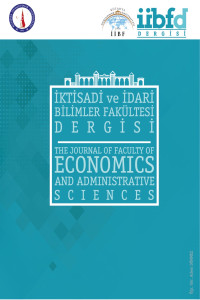Öz
The aim of this study is to analyze the main economic effects of the monetary policies implemented in Turkey after 2021. Monetary policies implemented in 2021 reflect an unorthodox approach, unlike the policies implemented before 2000. As a result of these policies based on keeping interest rates low, the inflation rate rose to double digits and central bank reserves melted rapidly. As of the second half of 2023, orthodox policies have been returned and improvements in macroeconomic balances have begun. Despite the orthodox policies implemented since the second half of 2023, there is no significant decrease in the inflation rate. There is a partial improvement in reserves. Whether orthodox policies produce the desired results in Turkey depends on the continuity of these policies and the inflow of foreign capital.
Anahtar Kelimeler
Kaynakça
- Binici M., Erol, H., Kara H., Özlü P. and Ünalmış, D. (2013). Faiz Koridoru Bir Makro İhtiyati Araç Olabilir mi?. TCMB Ekonomi Notları, No:2013-20.
- Bulut, N. and Erdil, S. (2023). Döviz Dönüşümlü Kur Korumalı Mevduat Hesabı ve Muhasebeleştirilmesi, Akademik İzdüşüm Dergisi, 8 (1): 495-524.
- CBRT (2001). Annual Report 2000, Ankara.
- CBRT (2002). Monetary Policy and Exchange Rate Policy in 2002 and Prospective Developments. lease, Press Release.
- CBRT (2013). CBRT Bulletin, March, Issue: 26.
- CBRT (2023a). Press Release on Interest Rates, (2023-22).
- CBRT (2023b). Summary of the Monetary Policy Committee Meeting, (2023-24).
- CBRT (2023c). Summary of the Monetary Policy Committee Meeting, (2023-25) .
- CBRT (2023d). Summary of the Monetary Policy Committee Meeting, (2023-32).
- CBRT (2023e). Summary of the Monetary Policy Committee Meeting, (2023-35).
- CBRT (2023f). Summary of the Monetary Policy Committee Meeting, (2023-39).
- CBRT (2023g). Inflation Report 2023-III, 27 July 2023.
- CBRT (2023h). Inflation Report 2023-IV, 2 November 2023.
- Çakalı, K. R. and Baloğlu, G. (2022). Kur Korumalı Türk Lirası Mevduat Hesaplarının Muhasebeleştirilme Esasları, PIAR, 9(22): 564-376.
- Çetin, M. Ö. (2016). Türkiye Cumhuriyet Merkez Bankası Para Politikası Uygulamalarının Gelişimi, Finansal Araştırmalar ve Çalışmalar Dergisi, 8(14): 67-101.
- Doğan, S. (2006). 2000li Yıllarda Türkiye’nin Ekonomik İstikrar Arayışları, İstanbul Üniversitesi İktisat Fakültesi Maliye Araştırma Merkezi Konferansları, 49. Seri.
- Eroğlu, N. (2009). Türkiye’de 1990’lı ve 2000’li Yıllarda Para Politikaları. Marmara Üniversitesi İ.İ.B.F. Dergisi, Cilt XXVI, Sayı 1.
- Köstekçi, A and Özbay, F. (2023). Kur Korumalı Mevduat Sistemi ve Vergilemenin Amaçları Üzerine Bir Değerlendirme, Business, Economics and Management Research Journal, 6 (1): 44-56.
- Önder, T. (2005). Para Politikası Araçları Amaçları ve Türkiye Uygulaması. TCMB Uzmanlık Yeterlilik Tezi, Ankara.
- Özatay, Fatih (2011). Parasal İktisat Kuram ve Politika. 2. Baskı. Efil Yayınevi. Ankara.
Öz
The aim of this study is to analyze the main economic effects of the monetary policies implemented in Turkey after 2021. Monetary policies implemented in 2021 reflect an unorthodox approach, unlike the policies implemented before 2000. As a result of these policies based on keeping interest rates low, the inflation rate rose to double digits and central bank reserves melted rapidly. As of the second half of 2023, orthodox policies have been returned and improvements in macroeconomic balances have begun. Despite the orthodox policies implemented since the second half of 2023, there is no significant decrease in the inflation rate. There is a partial improvement in reserves. Whether orthodox policies produce the desired results in Turkey depends on the continuity of these policies and the inflow of foreign capital.
Anahtar Kelimeler
Kaynakça
- Binici M., Erol, H., Kara H., Özlü P. and Ünalmış, D. (2013). Faiz Koridoru Bir Makro İhtiyati Araç Olabilir mi?. TCMB Ekonomi Notları, No:2013-20.
- Bulut, N. and Erdil, S. (2023). Döviz Dönüşümlü Kur Korumalı Mevduat Hesabı ve Muhasebeleştirilmesi, Akademik İzdüşüm Dergisi, 8 (1): 495-524.
- CBRT (2001). Annual Report 2000, Ankara.
- CBRT (2002). Monetary Policy and Exchange Rate Policy in 2002 and Prospective Developments. lease, Press Release.
- CBRT (2013). CBRT Bulletin, March, Issue: 26.
- CBRT (2023a). Press Release on Interest Rates, (2023-22).
- CBRT (2023b). Summary of the Monetary Policy Committee Meeting, (2023-24).
- CBRT (2023c). Summary of the Monetary Policy Committee Meeting, (2023-25) .
- CBRT (2023d). Summary of the Monetary Policy Committee Meeting, (2023-32).
- CBRT (2023e). Summary of the Monetary Policy Committee Meeting, (2023-35).
- CBRT (2023f). Summary of the Monetary Policy Committee Meeting, (2023-39).
- CBRT (2023g). Inflation Report 2023-III, 27 July 2023.
- CBRT (2023h). Inflation Report 2023-IV, 2 November 2023.
- Çakalı, K. R. and Baloğlu, G. (2022). Kur Korumalı Türk Lirası Mevduat Hesaplarının Muhasebeleştirilme Esasları, PIAR, 9(22): 564-376.
- Çetin, M. Ö. (2016). Türkiye Cumhuriyet Merkez Bankası Para Politikası Uygulamalarının Gelişimi, Finansal Araştırmalar ve Çalışmalar Dergisi, 8(14): 67-101.
- Doğan, S. (2006). 2000li Yıllarda Türkiye’nin Ekonomik İstikrar Arayışları, İstanbul Üniversitesi İktisat Fakültesi Maliye Araştırma Merkezi Konferansları, 49. Seri.
- Eroğlu, N. (2009). Türkiye’de 1990’lı ve 2000’li Yıllarda Para Politikaları. Marmara Üniversitesi İ.İ.B.F. Dergisi, Cilt XXVI, Sayı 1.
- Köstekçi, A and Özbay, F. (2023). Kur Korumalı Mevduat Sistemi ve Vergilemenin Amaçları Üzerine Bir Değerlendirme, Business, Economics and Management Research Journal, 6 (1): 44-56.
- Önder, T. (2005). Para Politikası Araçları Amaçları ve Türkiye Uygulaması. TCMB Uzmanlık Yeterlilik Tezi, Ankara.
- Özatay, Fatih (2011). Parasal İktisat Kuram ve Politika. 2. Baskı. Efil Yayınevi. Ankara.
Ayrıntılar
| Birincil Dil | İngilizce |
|---|---|
| Konular | Para Politikası |
| Bölüm | Araştırma Makaleleri |
| Yazarlar | |
| Erken Görünüm Tarihi | 29 Aralık 2023 |
| Yayımlanma Tarihi | 29 Aralık 2023 |
| Gönderilme Tarihi | 24 Aralık 2023 |
| Kabul Tarihi | 28 Aralık 2023 |
| Yayımlandığı Sayı | Yıl 2023 Sayı: 12 |


